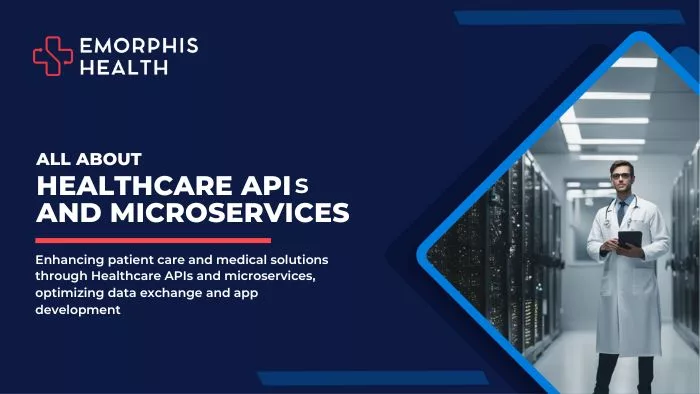Healthcare APIs
See Contents
Healthcare APIs (Application Programming Interfaces) play a crucial role in enabling data exchange, healthcare interoperability, and integration between various healthcare systems, applications, and devices. Here’s an overview of key concepts and considerations:
- Interoperability Standards: Healthcare APIs often adhere to standards like HL7 FHIR (Fast Healthcare Interoperability Resources) for data exchange. FHIR provides a structured way to represent healthcare data, making it easier to develop consistent APIs.
- Data Privacy and Security: Patient data security is paramount. APIs should support data encryption (using HTTPS), user authentication (OAuth or API keys), and access controls to ensure that only authorized parties can access and manipulate patient data.
- API Design: Well-designed APIs follow RESTful principles, providing endpoints for various operations (GET, POST, PUT, DELETE). Clear endpoint naming, proper versioning, and consistent response structures enhance usability.
- Data Mapping and Transformation: Since different healthcare systems may store data differently, APIs often include data mapping and transformation logic to ensure seamless data exchange while conforming to standards.
- Rate Limiting and Throttling: Implementing rate limiting and throttling mechanisms prevents abuse of APIs and ensures fair usage among consumers, preventing performance degradation.
- Error Handling and Logging: Robust error handling with appropriate HTTP status codes and informative error messages enhances API reliability. Detailed logging helps diagnose issues during integration.
- API Documentation: Comprehensive documentation, including usage instructions, sample requests, and responses, aids developers in integrating with the API effectively.
Microservices in Healthcare
Microservices architecture involves breaking down complex applications into smaller, loosely coupled services, each responsible for a specific business function. In healthcare, microservices can offer scalability, maintainability, and flexibility. Consider the following aspects:
- Service Decomposition: Identify distinct healthcare functionalities, such as patient management, appointment scheduling, and billing. Each of these can be encapsulated as a separate microservice.
- Containerization and Orchestration: Technologies like Docker enable packaging microservices and their dependencies into containers, ensuring consistent environments across development, testing, and production. Kubernetes can manage these containers efficiently.
- Data Management: Each microservice might have its own data store (database) optimized for its specific needs. Data consistency and synchronization can be achieved through careful design and event-driven architecture.
- API Gateway: An API gateway serves as the entry point for external requests, routing them to the appropriate microservices. It can handle tasks like load balancing, security, and request transformation.
- Event-Driven Architecture: Using message queues or event buses, microservices can communicate asynchronously. This is particularly useful in scenarios like updating patient records across multiple services without tight coupling.
- Fault Isolation and Resilience: Microservices should be designed to handle failures independently, promoting fault isolation. Implementing circuit breakers and retries can enhance overall system resilience.
- Monitoring and Observability: Tools like Prometheus and Grafana help monitor and gather metrics from microservices. Logging and tracing mechanisms aid in diagnosing issues and tracking requests across services.
- Deployment and CI/CD: Automation in deployment (using tools like Jenkins or GitLab CI/CD) ensures rapid and consistent updates to microservices while maintaining quality.
- Scalability: Microservices can be scaled independently based on demand, optimizing resource utilization and ensuring performance during high-traffic periods.
By embracing healthcare APIs and microservices, the industry can achieve greater interoperability, modularity, and flexibility in developing and maintaining healthcare software solutions.
Check out Healthcare Integration Services Now!
What are the various types of Healthcare APIs and Microservices?
In the realm of healthcare, APIs (Application Programming Interfaces) and microservices play a crucial role in enabling interoperability, data exchange, and the development of innovative healthcare applications. Here are various types of healthcare APIs and microservices:
1. EHR (Electronic Health Record) APIs
Electronic Health Record APIs facilitate the exchange of patient health data between different electronic health record systems. They allow authorized applications to access and update patient information securely.
2. FHIR (Fast Healthcare Interoperability Resources) APIs
As a matter of fact, FHIR is a standard for exchanging healthcare information electronically. FHIR APIs enable the retrieval and manipulation of healthcare data in a standardized format, making it easier to share data between different healthcare systems and applications.
3. DICOM (Digital Imaging and Communications in Medicine) APIs
DICOM APIs are used for exchanging medical images and related information, such as X-rays, MRIs, and CT scans, between different medical imaging devices and systems.
4. Telemedicine APIs
Telemedicine APIs support the development of telehealth applications, allowing for remote consultations, video conferencing, and remote patient monitoring.
5. Pharmacy APIs
Pharmacy APIs can connect electronic prescription systems, medication databases, and pharmacy management systems to facilitate medication orders, refills, and drug interaction checks.
6. Laboratory APIs
Laboratory APIs help integrate laboratory information systems with other healthcare systems, making it easier to order, process, and access lab test results.
7. Payment and Billing APIs
Payment and billing APIs are used for processing healthcare-related financial transactions, insurance claims, and billing information.
8. HL7 (Health Level Seven) APIs
HL7 APIs are based on the HL7 standard, which defines a framework for exchanging, integrating, sharing, and retrieving electronic health information.
9. Patient Engagement APIs
These APIs enable the development of patient-facing applications that provide features like appointment scheduling, health record access, medication reminders, and health monitoring.
10. Healthcare Analytics APIs
Analytics APIs provide access to healthcare data analysis tools, enabling the creation of applications that help healthcare professionals make informed decisions based on data insights.
11. Wearables and IoT APIs
APIs that connect with wearable devices and IoT (Internet of Things) healthcare devices allow for the collection and sharing of real-time patient data for monitoring and diagnosis.
Microservices in Healthcare
Microservices architecture involves breaking down complex applications into smaller, loosely coupled services. In healthcare, microservices can be applied to various aspects:
- Patient Management Microservices: Handling patient registration, scheduling, and record management.
- Appointment Microservices: Managing appointments and sending reminders.
- Billing and Payment Microservices: Handling billing, insurance claims, and payment processing.
- Clinical Microservices: Facilitating specific clinical functionalities, like lab result processing or radiology.
- EHR Microservices: Dealing with electronic health record data storage and retrieval.
- Analytics Microservices: Providing data analysis and insights from healthcare data.
- Security and Compliance Microservices: Ensuring the security and compliance of healthcare applications.
These are just a few examples of how APIs and microservices are utilized in the healthcare industry to improve interoperability, efficiency, and patient care. The adoption of these technologies continues to grow as the healthcare sector becomes more digitized and patient-centric.
How do microservices support IT integration in healthcare?
Microservices play a significant role in supporting IT integration in healthcare by providing a flexible and scalable architecture that promotes interoperability, data exchange, and streamlined processes. Here’s how microservices contribute to IT integration in the healthcare sector:
a. Modular Architecture
Microservices break down large, monolithic healthcare applications into smaller, independently deployable modules. Each microservice focuses on a specific function or business process, making it easier to manage, update, and scale individual components without affecting the entire system.
b. Interoperability
Microservices allow different healthcare systems and applications to communicate and exchange data more seamlessly. Each microservice can have its API, facilitating standardized communication protocols and data formats, which is crucial for integrating diverse healthcare IT systems.
c. Data Exchange and Sharing
Microservices enable the efficient exchange of patient data between different systems, such as electronic health records (EHRs), lab systems, imaging systems, and more. This data sharing is vital for providing comprehensive patient care and informed decision-making.
d. Easier Integration of Third-Party Services
Healthcare organizations often use various third-party services for functions like payment processing, analytics, and telemedicine. Microservices can be designed to integrate with these external services, enhancing the overall capabilities of the healthcare application.
e. Scalability
In healthcare, demand can vary significantly, especially during peaks such as flu seasons or pandemics. Microservices’ modular nature allows for dynamic scaling of specific components to handle increased load, ensuring optimal performance without having to scale the entire application.
f. Faster Development and Deployment
Microservices enable teams to work independently on different components of an application. This parallel development approach speeds up the development lifecycle and allows for quicker deployment of updates and new features.
g. Flexibility in Technology Stacks
Different microservices within a healthcare application can be developed using different programming languages, frameworks, and technologies that best suit their specific requirements. This flexibility allows organizations to choose the right tool for the job without being tied to a single technology stack.
h. Risk Mitigation
If a particular microservice encounters issues or needs maintenance, it can be addressed without affecting the entire system. This compartmentalization helps mitigate risks associated with system failures or downtime.
i. Continuous Integration and Delivery (CI/CD)
Microservices architecture aligns well with CI/CD practices, allowing for automated testing, integration, and deployment of individual services. This leads to faster updates, improved quality, and reduced downtime.
j. Enhanced Patient Experience
Microservices enable the development of patient-facing applications, such as telemedicine platforms and patient portals. These applications can offer a seamless and user-friendly experience, allowing patients to access their records, schedule appointments, and interact with healthcare providers more conveniently.
k. Adaptation to Regulatory Changes
The healthcare industry is subject to evolving regulatory requirements. Microservices can help organizations adapt to these changes more efficiently by allowing for targeted updates to meet compliance needs.
Microservices provide the foundation for creating a flexible, interoperable, and agile IT ecosystem within the healthcare sector. By embracing microservices architecture, healthcare organizations can achieve better integration, more efficient workflows, and improved patient care.
Choose Emorphis for Healthcare Integration services
Emorphis Technologies excels in providing best-in-class Healthcare Integration services, setting a remarkable standard in the industry. With a deep understanding of healthcare software product engineering, Emorphis Technologies delivers seamless integration solutions that empower healthcare organizations to optimize their operations.
Emorphis Technologies stands as a pioneering force in the realm of healthcare API integration services, offering a comprehensive suite of solutions that seamlessly bridge the gap between diverse healthcare systems and applications. With a robust emphasis on the power of APIs and microservices, Emorphis empowers healthcare organizations to enhance their operational efficiency, patient care, and data management.
Through strategically designed APIs, Emorphis enables the integration of disparate healthcare software, allowing for the secure and efficient exchange of critical patient information, administrative data, and clinical insights. These APIs serve as the connective tissue that weaves together electronic health records (EHR) systems, telemedicine platforms, billing systems, and other crucial healthcare components.
Furthermore, Emorphis’s expertise in microservices architecture provides a dynamic approach to building and scaling healthcare solutions. By breaking down complex applications into smaller, modular microservices, they enable organizations to update, deploy, and maintain different components independently. This fosters agility, scalability, and easier maintenance in an ever-evolving healthcare landscape.
Emorphis Technologies’ dedication to security and compliance ensures that all API integrations and microservices adhere to stringent healthcare data regulations, such as HIPAA and GDPR. This commitment to data privacy and protection is integral to maintaining patient trust and safeguarding sensitive information.
Conclusion
In a healthcare environment where interoperability and real-time data exchange are paramount, Emorphis Technologies stands out as a trusted partner. Their healthcare API integration services and innovative microservices approach not only streamline operations but also lay the foundation for future advancements in healthcare technology. With Emorphis at the helm, healthcare organizations can navigate the complexities of data integration with confidence, unlocking new levels of efficiency and patient-centered care.









